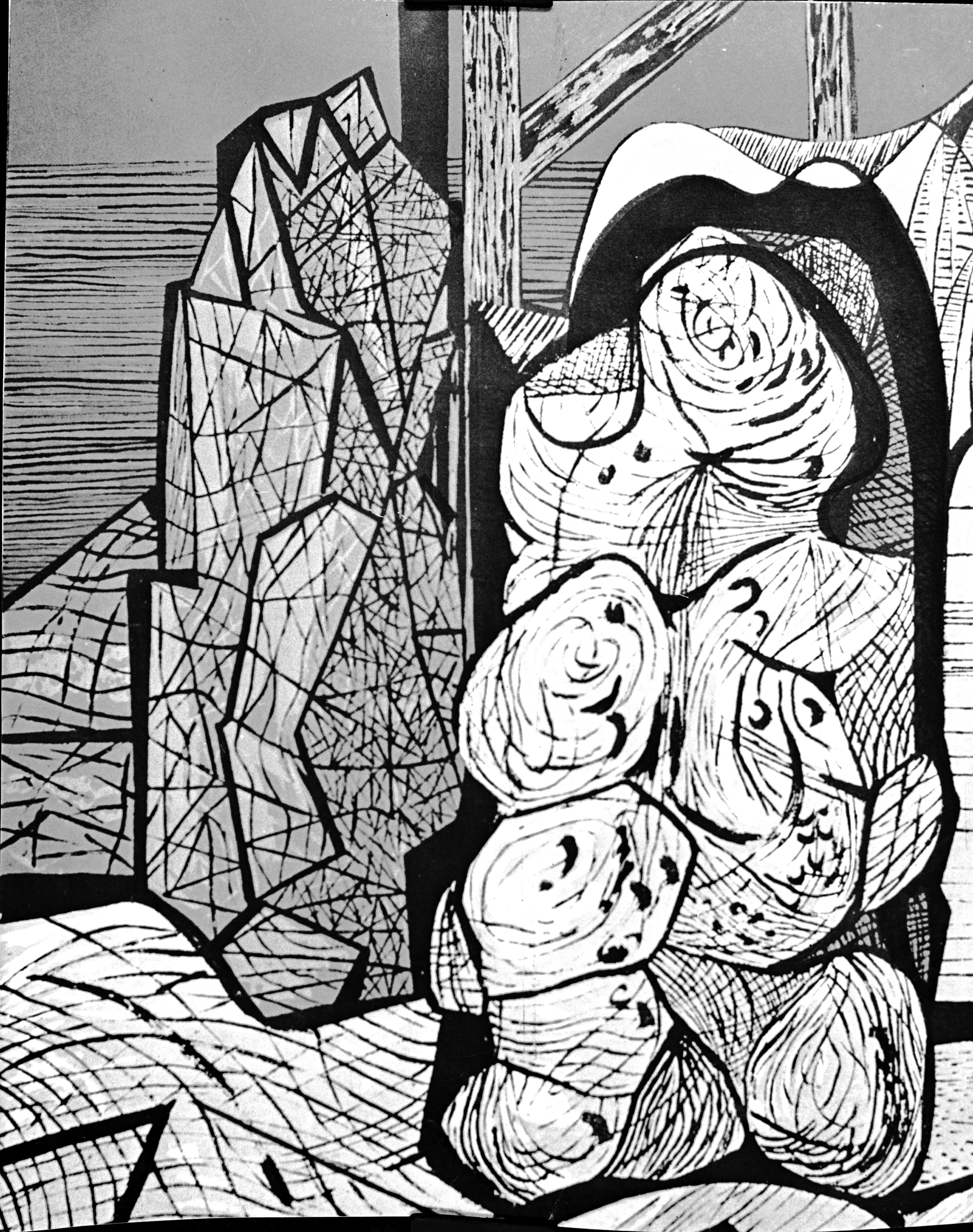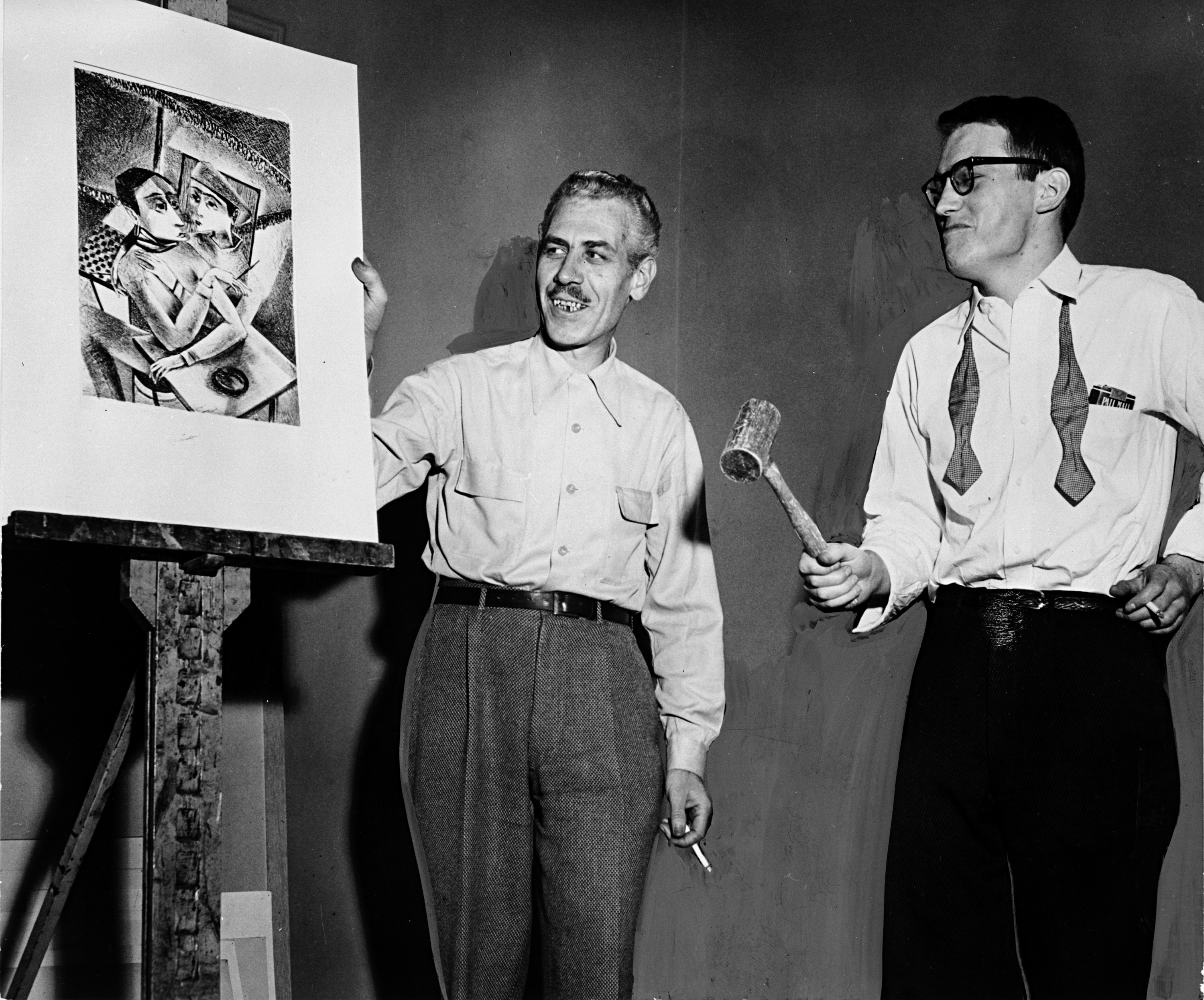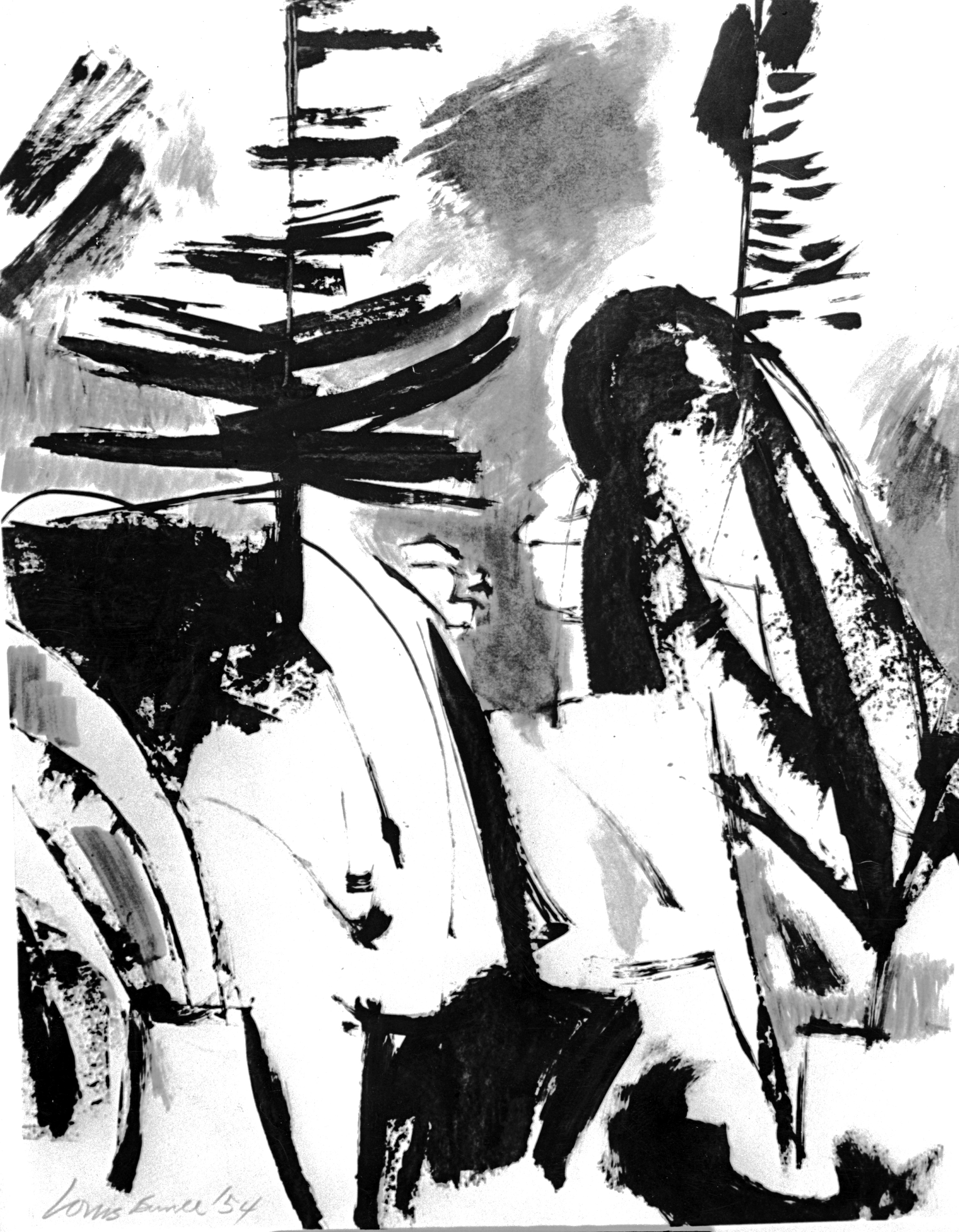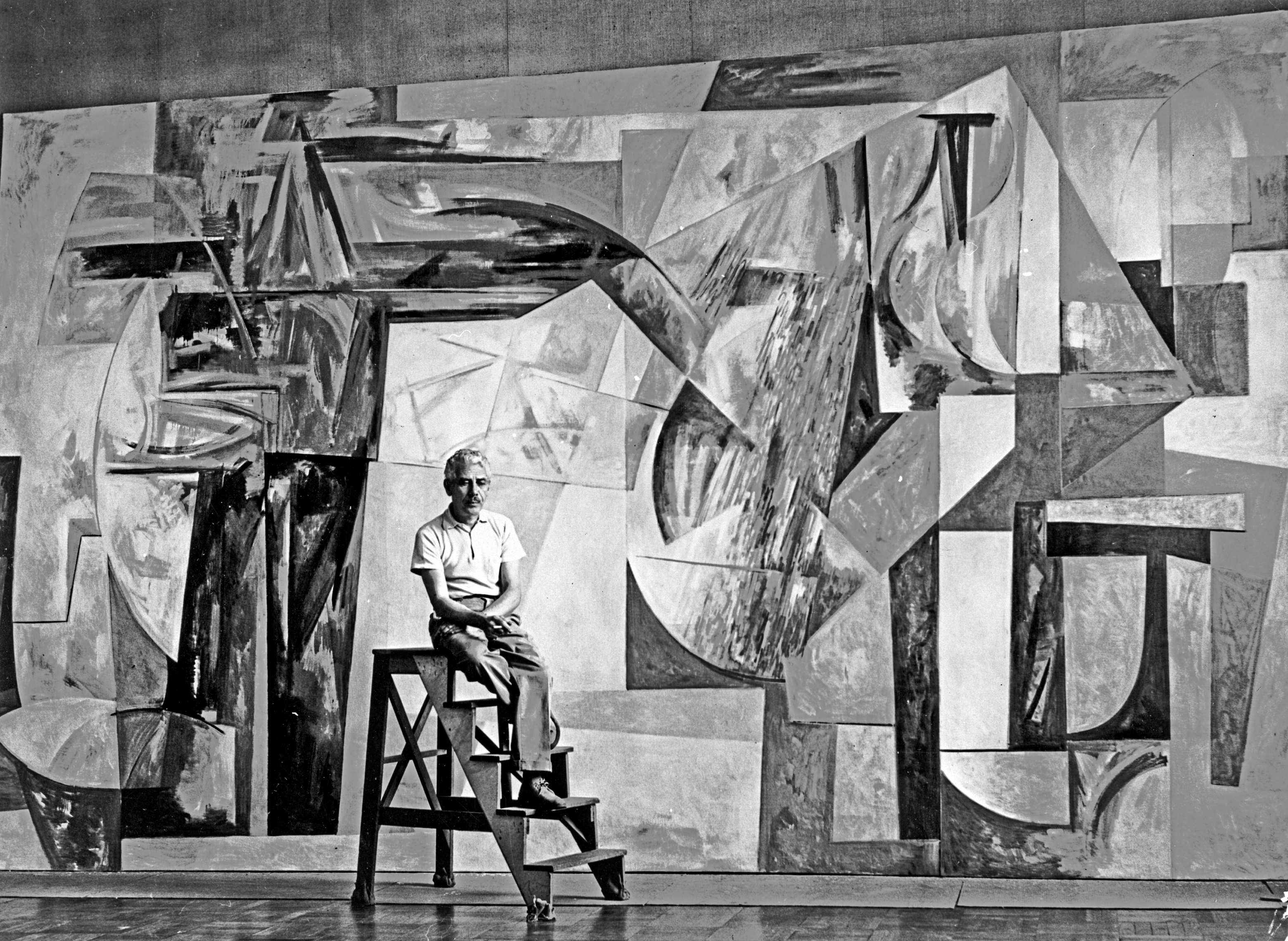Louis Bunce, a major painter and printmaker beginning in the 1930s, is considered a legend in Oregon modernism. Known for variations of Surrealism and Cubism in the 1930s and 1940s, nature-based adaptations of Abstract Expressionism in the 1950s and 1960s, and geometric compositions related to Minimalism in the 1970s, he created a body of work that resonates with international modern art. He influenced many artists in the Pacific Northwest, including those who studied with him at the Museum Art School (now Pacific Northwest College of Art), where he taught from 1946 until 1972.
Louis Demott Bunce was born in Lander, Wyoming, and moved with his family to Portland in 1920. He studied at the Museum Art School in 1925-1926, befriending fellow student William Givler. Both enrolled at the Art Students League in New York, Bunce studying there during 1927-1931.
In Oregon, Bunce participated in the Public Works of Art Project in Portland in 1934, and in 1936 assisted John Ballator in painting murals for the St. Johns Post Office. These were funded by the U.S. Treasury Department, which also commissioned Bunce to paint the mural of Native American life for the Grants Pass Post Office. During the period 1937-1939, he was a teacher and then associate director for the WPA Federal Art Center in Salem, where he collaborated with his students, including Clifford Gleason, in painting murals for Bush Elementary School. He met and married Eda Hult in Salem.
In 1940, Bunce returned to New York and worked as a WPA muralist and easel painter until 1942. Living in New York for two extended periods and visiting almost annually for many years thereafter helped him establish links between the art communities in Portland and New York, where he knew Jackson Pollock, Willem de Kooning, Robert Motherwell, Franz Kline, and other key figures in American modernism.
During World War II, Bunce worked as illustrator and tool designer for the Oregon Shipbuilding Corporation, and in 1946 William Givler, by then dean of the Museum Art School, hired him as a faculty member. In 1949, Bunce and his wife established the Kharouba Gallery, the first in Portland devoted to showcasing experimental avant-garde art by artists working in Portland and further afield. Bunce’s abstract mural for Portland International Airport created controversy in 1958, when the debate between “modern” and “traditional” artists was at its height in Oregon.
Bunce’s figurative Surrealism and Cubism of the 1930s and 1940s gave way to more complete abstraction in his paintings, drawings, serigraphs, and lithographs of the 1950s and on, but references to landscape, human figures, or still life are nearly always present in understated ways. The Oregon coast, Columbia Gorge, and Portland and its environs were attractive to Bunce, and many of his works involve subtle effects of light, space, and natural textures.
Bunce exhibited in numerous exhibitions in the Pacific Northwest, California, the Midwest, and the East Coast, including “American Painting Today” at the Metropolitan Museum of Art (1950), Whitney Museum of American Art annuals (1951, 1953, 1955, 1959), and “Art of the Pacific Northwest” organized by the Smithsonian Institution’s National Collection of Fine Arts (1974). He showed his work at the Meltzer Gallery in New York in the 1950s, and beginning in the 1960s was long affiliated with the Fountain Gallery of Art in Portland. His works are in the collections of the Portland Art Museum, Seattle Art Museum, Reed College, Henry Art Gallery (University of Washington), Jordan Schnitzer Museum of Art (University of Oregon), Hallie Ford Museum of Art (Willamette University), Whitney Museum of American Art, San Francisco Art Institute, and many other public and private collections.
While suffering from cancer, Louis Bunce died of an aneurism in Portland on June 11, 1983, at age seventy-five.
-
![Louis Bunce, "Jetty Rocks No. 1" (serigraph), Nov. 1951.]()
Bunce, Louis, Jetty Rocks No. 1, 1951, bb003385.
Louis Bunce, "Jetty Rocks No. 1" (serigraph), Nov. 1951. Oreg. Hist. Soc. Research Lib., bb003385
-
![Louis Bunce (l) and Manuel Izquierdo serve as auctioneers at Portland Art Museum's benefit for Michele Russo, Nov. 1951.]()
Bunce, Louis, and Izquierdo, Manuel, Nov. 1951, bb003368.
Louis Bunce (l) and Manuel Izquierdo serve as auctioneers at Portland Art Museum's benefit for Michele Russo, Nov. 1951. Oreg. Hist. Soc. Research Lib., bb003368
-
![Louis Bunce, "Coast Landscape" (oil wash), won purchase prize in Oregon Art Show, Sep. 1954.]()
Bunce, Louis, Coast Landscape, 1954, bb003388.
Louis Bunce, "Coast Landscape" (oil wash), won purchase prize in Oregon Art Show, Sep. 1954. Oreg. Hist. Soc. Research Lib., bb003388
-
![Bunce with mural for Portland airport terminal.]()
Bunce, Louis, PDX mural, bb003369.
Bunce with mural for Portland airport terminal. Oreg. Hist. Soc. Research Lib., bb003369
Map This on the Oregon History WayFinder
The Oregon History Wayfinder is an interactive map that identifies significant places, people, and events in Oregon history.
Further Reading
Hull, Roger. Louis Bunce: Dialogue with Modernism. Salem: Hallie Ford Museum of Art, 2017.
Allen, Ginny and Jody Klevit. Oregon Painters, The First Hundred Years (1859-1959). Portland: Oregon Historical Society Press, 1999.
Harmon, Kitty. The Pacific Northwest Landscape: A Painted History. Seattle: Sasquatch Books, 2001.
Rosenfield, Rachel. Louis Bunce, A Retrospective. Catalogue for an exhibition at the Portland Art Museum (Nov. 21-Dec. 30, 1979).




